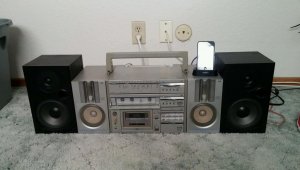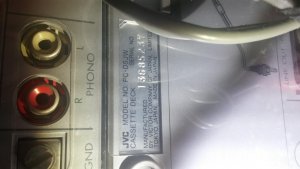Bypass existing amp and install modern amp?
- Thread starter Barb Bush
- Start date
You are using an out of date browser. It may not display this or other websites correctly.
You should upgrade or use an alternative browser.
You should upgrade or use an alternative browser.
- Status
- Not open for further replies.
caution
Member (SA)
I guess it depends on how skilled you are with rework and understanding a schematic, and if there even is one for the box you want to do this to.It would take some time to understand how the stock amp integrates with the rest of the unit's circuitry. I'd say as long as there isn't anything funky that needs to be there for the pre-amp to work right, or components within the original amp circuit that are there to help maximize the performance of the speakers used in that specific box, you'd be fine. Might lose a few original under-the-hood niceties, but that may not matter.
Lasonic TRC-920
Moderator
This has been a subject I have both inquired about and tackled in my earlier days here on Boomboxery.Barb Bush said:Has anyone tackled bypassing the existing output amp of a boombox and install a new modern amp in its place? Maintain all the functionality of the box but have new cleaner sound? Are the circuit boards too complex to try this?
Is this just a dumb idea? Please advise.
Back in 2010 I built a project called LOUDER BLASTER You can see it here. It included me adding an amp to the system, but not bypassing the old amp, it was ADDING it after the existing amp. It works, but it's dirty sounding, but loud as F**K.
The issue with by passing the old amp and using a new amp (as it has been explained to me by far more knowledgeable people) is that you first have to intercept the signal on the amp board on it's pathway to the amp chip, re-route it to the new amp and then route it back into the system. The issue I have been told with this is, all the components that now follow the new amp weren't designed for it, which introduces a ton of other unwanted reactions.....OR SOMETHING ALONG THOSE LINES. (my rough explanation).
As best I have seen, you can get an all in one Bluetooth, FM receiver, amp board and just by pass or gut the boombox and wire this board in it's place and too the speakers and presto, your going for it.
This question is very generic but the answer would need to be specific to the application. Boomboxes frequently have other sub circuits and paths such as headphone circuit, speaker outs, etc that intercepts the output if such external load devices were plugged in. One problem is that most classic amps where one would be interested in adapting a modern amp (those with less power) are typically single ended systems that have common grounds in the outputs. You probably can't just remove such an amp and stuff in it's place a modern amp as if the entire system is modular -- it is not. Most modern amps that have decent power would be bridged amplifiers and those have floating grounds. Neither pin of the outputs on BTL designs can be grounded, yet that is exactly how the system would likely switch the headphone jacks if originally designed in SE configuration. Even on boomboxes that originally had BTL configuration, it's not for certain you can plug in another BTL amp without modification since the orig headphone setup would be configured to work specifically for the amp installed in that application -- it's no guarantee that the circuit design would work in another BTL application. You can get around this to some extent by routing the new outputs directly to the speakers thereby bypassing all the other stuff but that isn't a drop in replacement since some features will no longer work. Also you may also experience some ground loop issues in the retrofit which will manifest as hum since the original design and the new amp may have different paths to ground and minute current traveling through circuitous unintended paths back to ground will definitely introduce hum.
Transistorized
Member (SA)
This might not be the correct way but if I were to try this I'd simply tap off the headphone jack and feed that into the inputs of a mini car amplifier. As long as the stereo took 12 to 15volts worth of batteries I could then share the batteries or a modified power supply/brick capable of supplying the amperage and correct voltage to the whole unit. Then I'd replace the speakers and leave the factory wiring terminated from the speakers and run new speaker wires from the replacement amp. This way the stock amp and volume would still work, the headphone jack would still work and no modifications would need to be made to the board of the radio (aside from the soldered connections from the headphone jack to the amp). Yes this is after the built in amp so probably won't get crystal clear sound but it seems much easier than trying to trace the signal path to the source and then you'd have to use a separate volume from the one on the unit.
Simple easy and can be easily undone if you wanted to convert back
Simple easy and can be easily undone if you wanted to convert back

FWSnake
Member (SA)
jimmyjimmy19702010
Member (SA)
I'm thinking it's not really worth the efffort - I mean, you can't up the power substantially without upgrading the speakers. Speakers with higher power handling capabilities typically have bigger magnets etc which makes things very tight in your typical Japanese built one piece box.
The sound quality of a good quality boombox amp is actually pretty good. The things that ultimately hold a boomer back from sounding better are equalisation issues (strong mids and weak bass) and open backed cabinet designs.
The sound quality of a good quality boombox amp is actually pretty good. The things that ultimately hold a boomer back from sounding better are equalisation issues (strong mids and weak bass) and open backed cabinet designs.
Yep, just an idea. Thanks for the feedback. I was thinking about upgrading the amp in my PC-5 but found that it isn't the amp that is weak, its the speakers. Fostex drivers are tired, overdriven.
Tested the amp last night by plugging in some Polks, it is clear and powerful.
Tested the amp last night by plugging in some Polks, it is clear and powerful.
Attachments
Transistorized
Member (SA)
Nice looking JVC.
You know....the cassette deck mechanism looks an awful lot like the JVC RC-M90. The eject button along with the side controls gives it away. Hmmm.
What's the model of this box?
You know....the cassette deck mechanism looks an awful lot like the JVC RC-M90. The eject button along with the side controls gives it away. Hmmm.
What's the model of this box?
Transistorized
Member (SA)
Thanks caution. I saw your M90 cassette deck repair thread. While mine is working good now I've always got my eyes peeled for much needed future parts...lol
It appears it is a JVC MODEL PC-D5JW.Transistorized said:Nice looking JVC.
You know....the cassette deck mechanism looks an awful lot like the JVC RC-M90. The eject button along with the side controls gives it away. Hmmm.
What's the model of this box?
Attachments
Transistorized
Member (SA)
ThanksBarb Bush said:It appears it is a JVC MODEL PC-D5JW.Nice looking JVC.
You know....the cassette deck mechanism looks an awful lot like the JVC RC-M90. The eject button along with the side controls gives it away. Hmmm.
What's the model of this box?

- Status
- Not open for further replies.



